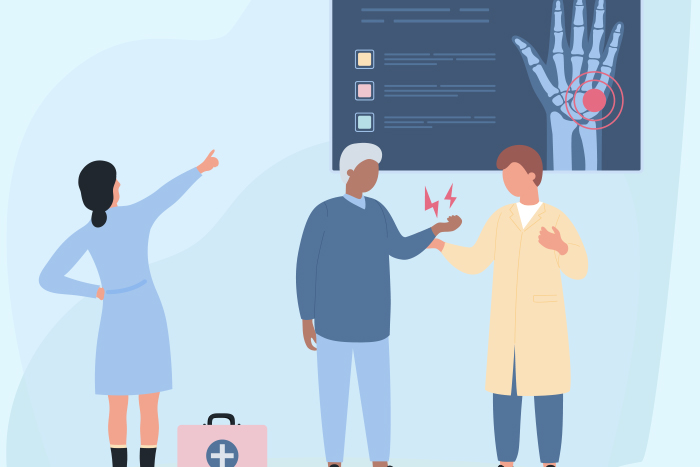Understanding Arthritis
If you’ve been told you have arthritis, you’re not alone. Millions of older adults live with this condition. While the word arthritis can sound scary, knowing what it is and how to manage it can make a big difference. Let’s walk through the basics together—what arthritis is, how it affects your body, and what you can do to feel your best.
What is arthritis?
Arthritis means inflammation or swelling in the joints—the parts of your body where bones meet, like your knees, hips, fingers, or spine. When you have arthritis, your joints may feel painful, stiff, or swollen. You might notice it’s harder to move or do everyday tasks like walking, bending, or opening a jar.
There are more than 100 types of arthritis, but the two most common types in older adults are:
Osteoarthritis (OA): The “wear-and-tear” kind that happens over time
Rheumatoid Arthritis (RA): An autoimmune disease where the body attacks its own joints
What causes arthritis?
Osteoarthritis happens when the cartilage (a smooth, rubbery layer that cushions your joints) breaks down over time as we age . As the cartilage wears away, bones can rub together, causing pain and stiffness. This usually develops slowly and becomes more common with age.
Rheumatoid arthritis is different. It’s caused by your immune system—your body’s defense against illness—mistakenly attacking the lining of your joints. This can cause pain, swelling, and even damage to the joint over time.
Other causes of arthritis include past joint injuries, infections, or family history. Some people are more likely to get arthritis if they are overweight or have certain health conditions.
Common Symptoms of Arthritis
Arthritis symptoms can come and go. You may feel fine one day and stiff or sore the next. Common signs include:
Joint pain or aching
Stiffness, especially in the morning or after resting
Swelling around the joints
Reduced range of motion
A grinding feeling or sound in the joint (with osteoarthritis)
In rheumatoid arthritis, you might also notice fatigue, low fever, or feeling generally unwell.
If you’re noticing these symptoms, it’s important to talk with your doctor. Addressing your arthritis symptoms early can help you manage them better.
Arthritis Complications
Without treatment, arthritis can sometimes lead to more serious issues. For example, ongoing inflammation may damage the joints or lead to deformities, especially in rheumatoid arthritis. It may also limit your ability to walk, dress, cook, or do other everyday tasks.
Some people with arthritis may also be at higher risk for depression or social isolation due to pain and limited mobility. But with the right support and care, these complications can often be prevented or reduced.
How is arthritis treated?
Getting an arthritis diagnosis can feel overwhelming at first—but there’s good news: while there’s no cure, there are many effective ways to manage the symptoms and protect your joints. The right treatment plan can help reduce pain, improve how your joints work, and keep you moving.
Many people with arthritis start treatment with over-the-counter (OTC) medicines to help manage pain and swelling.
Acetaminophen (Tylenol) can relieve pain but doesn’t reduce swelling.
NSAIDs, such as ibuprofen (Advil, Motrin) or naproxen (Aleve), help ease both pain and inflammation.
If OTC meds aren’t enough, your doctor may suggest prescription options:
Stronger NSAIDs for more advanced pain relief
Corticosteroids, such as prednisone, are used to reduce severe inflammation
Disease-modifying antirheumatic drugs (DMARDs) for rheumatoid arthritis (like methotrexate)
Biologics, a newer class of drugs for autoimmune arthritis (such as Enbrel or Humira)
These stronger medications usually require regular check-ins with your doctor to monitor side effects and make sure they’re working.
Always talk with your doctor before starting or stopping any medication. Even “natural” supplements can interact with other drugs or cause side effects.
Lifestyle Tips to Help With Arthritis
Even small changes can make a big difference in managing arthritis. Here are some tips to try:
Stay Active: Gentle movement helps keep joints flexible. Walking, swimming, or stretching can ease stiffness.
Maintain a Healthy Weight: Carrying extra weight puts more pressure on your joints, especially the knees and hips.
Use Joint-Friendly Tools: Special kitchen tools, shoehorns, or jar openers can reduce strain on your hands and wrists.
Balance Rest and Activity: Don’t push through pain, but avoid staying still too long either.
Apply Heat or Cold: Warm baths, heating pads, or ice packs can soothe sore joints.
Eat Well: Some studies suggest that a diet rich in fruits, veggies, fish, and whole grains may reduce inflammation.
And don’t forget to take care of your mental health. Living with chronic pain can be hard, so it’s okay to ask for support from family, friends, or a counselor.
You’re Not Alone
Arthritis is common—especially as we age—but that doesn’t mean you have to live in pain or stop doing the things you enjoy. By learning about your condition, staying active, and working with your healthcare team, you can keep moving and living well.
Remember: small steps make a big difference.
Sources:
Centers for Disease Control & Prevention: Arthritis Basics
Mayo Clinic: Arthritis
Cleveland Clinic: Arthritis
National Institute of Arthritis and Musculoskeletal and Skin Diseases: Arthritis

